Press HERE
for a timeline history of the Union Cemetery Association
A BRIEF HISTORY OF UNION CEMETERY
Before Union Cemetery
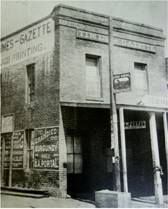
Times and Gazette Building
The first entry that mentioned a cemetery in the Times and Gazette
(which was the only newspaper in San Mateo County
at that time) was in early January 1859.
William Cary Jones had allowed 13 burials on his property,
the site of today's Sequoia High School.
Now that Horace Hawes had taken over the property, he
informed the county that he no longer wanted
the dead to be buried on his property and he wanted all 13
bodies exhumed and moved elsewhere. This caused great anxiety in Redwood City.
A meeting was held in the new courthouse soon after
the announcement, and Charles Fox, W. T. Gough and James
McCrea were appointed to look into the
legality of Mr. Hawes' decision. They
decided that he had the right, and
they recommended that a committee be established to
find a new cemetery location.

Charles N. Fox
A meeting held February 7, 1859 established a
committee to form an organization whose purpose
was to find a suitable location for a cemetery and
to develop rules of use and financing. Charles N. Fox, James W. Turner and John Vinton Diller,
accepted the challenge and went to work. A six
acre plot of land was located well out of town on
the road to the redwoods (Woodside Road) and a
purchase agreement was made by the three men and
Baird and Berry, the owners of the property.
Mr. Horace Hawes redeemed himself in the eyes of the
brr y when he donated a large portio
purchase price for the property.
Acquiring the Land for Union Cemetery
The Union Cemetery Association was formally
established at a meeting in the courthouse on
February 28, 1859. Committee members Fox, Turner
and Diller wrote a formal “Articles of Incorporation.” “This organization shall be known as the Union
Cemetery Association of San Mateo County in the
State of California ….. The sole and only object
of this Association shall be the purchase, support,
and maintenance of a cemetery for the burial of
the dead. Officers will be elected annually by
election ballot with majority vote.” It goes on
to elaborate that a vacancy will be filled in
the same manner.
These articles of incorporation were sent to the State
of California since there was no organization locally
that could legally accept them. A number of
communities were having similar problems establishing
new cemeteries
so the state took possession of
Union Cemetery. The incorporation papers were approved
on April 18, 1859.
The Start of the Union Cemetery
By May the cemetery had been established and a report
in the Gazette announced, “There are one
hundred and ninety-four family lots, all of good size and public ground sufficient
for over four hundred graves.”
The process of exhuming and moving the 13 bodies
from Hawes’ property to the cemetery began in May. The first to be moved was 4 year old Anna Augusta
Douglass. She was buried on Central Avenue about
mid cemetery. She was joined by her brother Nathan
who also died at age 4, but more than 10 years later. Walking down Central Avenue you can easily see the two small markers side by side.
The original entry to Union Cemetery was at the
east end near Woodside Road. The wagons proceeded
into the cemetery through an open gate that had
an arch over it. Roses were planted on each side
of the arch and they were bright red in the spring. It was a beautiful entry and the people of
Redwood City were proud of their cemetery.
Meetings in the American House
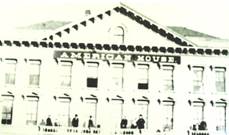
American House Hotel - corner of Main St. and A
St.
The Cemetery Association had been meeting in the
courthouse
since its inception but in April of
1873 it found a new
location in the American House
hotel
on Main Street at “A” Street. The change of officers
was announced at this meeting and a newspaper article
was submitted by Herman (H.A.) Schofield now the
secretary. Schofield, a well known attorney and
newspaper editor was one of the most prominent citizens of Redwood City.
A month later the annual meeting of the association
was convened at the American House. At this meeting
a new resolution was adopted, “Resolved… where
private lots are purchased by individuals, no burial
shall be permitted until the said lots are paid
for.” This was required because in several occasions
people had buried relatives in lots that had not
been paid for. A 12 by 12 building was ordered erected and a well with a pump was
to be completed. An election of officers was held
and Curtis Baird was elected President, Charles
Ayers was elected Superintendent and
George Wentworth became Secretary and Treasurer.
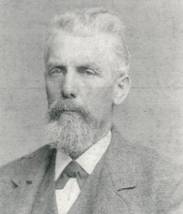
George Wentworth

George Rice
More Good Press
By 1876 the Times-Gazette newspaper wrote about the great
monuments that George H. Rice and George W. Fox
had erected even to the extent of naming the
manufacturer, Muldoon, Walton & Cobb of San Francisco.
Memorial Day, 1885, and the larger Group plots
An article in the Times-Gazette on May 30, 1885
announced that, “Today is Memorial Day and there
are no deceased members of the Grand Army of The
Republic in the cemetery.” One year later
the Grand Army of The Republic began meeting at the
Congregational Church and marching from the church
to the cemetery and decorating the grave of “the
late Will Frisbie.” The new post became the General
George S. Evans Post #72 of GAR. Shortly after that
a formal plot was established for the GAR and subsequent
burials were made in the new plot.
The Superintendent’s register showed that 345
interments as of 1878 and it listed the largest
majority were born in California. Something new
was added in this register, the designation of
specific large lots for several organizations, the
largest of which is the Odd Fellows lot at the rear
of the cemetery. They also listed the lots for
the Grand Army of The Republic, the Masonic Lodge
and for the Improved Order of Redmen.
The Grand Army of The Republic received an annual
grant of $100 from the county for upkeep of its
plot. Certainly the GAR was the most visible entity
with their annual Memorial Day march from the
Congregational Church (which stood on the northwest
corner of Middlefield and Jefferson), to the cemetery
and members were a colorful lot with all of them
wearing company uniforms that they received during the Civil War.
The GAR was deeply indebted to Mrs. Leland Stanford for her
generous donation of the statue of the soldier which stands
upon the towering pedestal that contains the words, “Mustered
Out.”
The people of southern San Mateo County and, more
specifically, the people of Redwood City were
beginning to recognize the value of this cemetery
in terms of the history of the people who were buried
there. The local citizens in the later part of the
19th Century were talking about “recognition.”
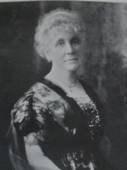
Geraldine Cooley
Memorial Day 1886
On Memorial Day 1886
Geraldine Cooley-Frisbie, organizer and chairwoman
of the “Women’s Relief Corps” an adjunct of the
GAR, gave a very moving speech at the church before
the march.
“To the officers and members of the General George
S. Evans Post 72 of the Grand Army of the Republic, Redwood City, I am requested to perform a very
pleasant duty. The ladies of San Mateo County have,
with true, loyal and patriotic zeal made a flag for your post.
“Words cannot express how deeply they realize and
appreciate the noble purpose that had called you
together today. I can imagine no word or act on
their part whereby they can prove their sincere
regard and esteem, and that you treasure more sacredly, than this old flag we all so dearly love, the
very sight of which causes the pulse of the nation
to beat with pride; whose colors so many times
have wafted intelligence of the movements of friend
or foe and under its starry folds you have so often
marched to victory.” Mrs. Cooley-Frisbie’s words
rang with the emotion of the moment.
The Cemetery in 1889
By 1889 the triangular lot that is 75 feet long
42 feet wide at the rear and 20 feet wide at the
front entrance was surrounded by 8X16 granite
coping. The monument now had emblems of the four
services on each of the sides. The inscription read:
“To the Memory of California’s Patriotic Dead, who served during the War for the Union. Mustered
Out.” On the opposite side it read, “Erected by
the Grateful People of San Mateo County.”
“It was built by the Western Marble and Granite
Company of San Jose and it was a handsome addition
to the cemetery” expressed the San Mateo County
Gazette on May 25th 1889.
November of the
same year revealed a dramatic increase in the number
of monuments in the cemetery. While people were
placing monuments for recently buried members of
families but others were also purchasing and locating
monuments for themselves or other older family members
The small house that was built a number of years
earlier and placed in the Odd Fellow’s plot was
removed following the burial of Judge Buck’s son,
Norman, who had been run over by a train. Judge
Buck would be buried there in the 1930s.
1923: GAR headstones and James Peace
The
Redwood City Standard of June 21, 1923, reported
that Mrs. Archer Kincaid and Mrs. Mary Winter,
representing the Women’s Relief Corps, were working
on getting proper headstones for the men buried
in the GAR plot. It was through their dedicated
efforts that the federal government recognized and
made the standard head stones we see today in that
plot. The newspaper article also addressed the fact
that James Peace was buried in the GAR plot. He
was an exception as he was never a soldier, but he
is considered to be the first person to raise the
American Flag in San Mateo County. Needless to say
he probably was also a good friend and drinking
buddy of a number of the men buried in the plot.
Memorial Day 1927
At the Memorial Day service at the cemetery in 1927 only four
Civil War veterans remained alive. They were P. P.
Chamberlain, Howard E. Woodward, George Shugart and W.
Werder.

Werder and Shugart
Joining the veterans for the ceremony were the Spanish
American Veterans, bands from as far away
as San Jose, the Boy Scouts and their color guard,
the Girl Scouts with their color guard, and members
of the American Legion.
Potter's Field and Woodside Road
A new policy established
long before 1945 called for the development of
a potter’s field, an area for the burial of the
indigent and poor. The area in question was against
the hedge alongside of Woodside Road. During that
period Woodside Road was two lanes; it wasn’t until
the mid 1960s that the road was widened to four
lanes. The state highway department simply removed
the hedge and graded and paved a second lane on
each side expanding the existing road by about
15 feet with the new shoulder included.
A California State Landmark and The National Register
of Historic Places
On July 12, 1945, Mary Cereghino, a newspaper reporter,
compiled an unofficial history of the cemetery
and through this process a title search was done.
During that same year Dr. Frank Stanger, with
Mrs. Cereghino’s paper in hand, wrote his own history
of Union Cemetery. All the research resulted in
further inquiry as to the agency responsible for
upkeep in the cemetery. Sometime (and I have not
been able to pinpoint exactly) City Ordinance #456
was enacted by the City Council. This ordinance
states, “An ordinance of the city of Redwood City
regulating burials and the sale of lots or plots
in Union Cemetery in said city.”
The ordinance
provided for a $300 fine or imprisonment in
the county jail for ninety days as a threat
for violating the ordinance. It was
therefore illegal to bury people except in
lots, or plots, owned by the family of the
deceased. All further burials were
prohibited.
The work done by Cereghino
and Stanger was instrumental in forming the
application for California State Landmark status.
No cemetery had ever been given this honor but
Union Cemetery history was so vivid that the State Office
of Historic Preservation felt it deserved a status
that many other cities had coveted but none had
received. So Union Cemetery was given California
State Landmark #816.
On March 26, 1963, Redwood
City Council passed Resolution 3667 accepting
a deed for Union Cemetery from the State of
California.
In 1975, the Archives Committee
of the library incorporated and then began work
to get the Cemetery on the National Register of
Historic Places. Jean Cloud, chairwoman of the
archives committee, and Nita Spangler, along with
several other members, began this challenging project.
This Historic Union Cemetery Association
In October 1991, Peak & Associates
and Woodward-Clyde Consultants began work on a
Cultural Resources Management Plan for Union
Cemetery.
A month later Brian, Kangas and Faulk agreed to
do an aerial laser survey of the cemetery for $5,000
and the city council authorized the expenditure.
In November of 1992, the Historic Union
Cemetery Association was formed as a non-profit
corporation. The original board consisted of Jean
Cloud, John Edmonds, Francis Hutchinson and Helen
Graves. The board sat down with the City Manager
and told him that members were going to do everything
possible to improve the cemetery and that the board
would work with the city’s park and recreation
department to accomplish that goal.
The
organization was approved and the park and recreation
department assigned Ramon Aguilar to the board as
liaison. The board began holding public meetings
and soon a number of people joined and helped efforts
to raise a membership list. Enough people joined
and paid the $10 annual dues that the board was
finally developing a financial foundation.
Recent Improvements
The condition of the cemetery was appalling
and the task before the board was daunting. However
the board was able to raise enough money to pay
V. Fontana and Sons, of Colma, to come down and fix
6 monuments for which the board had salvaged all
the parts. The restoration company was so impressed
with the project that it did twice as many monuments
as the board had planned. This was such a great
improvement that Fontana was invited two more times.
A descendant of the Pool family donated
$20,000 for replacement of the totally destroyed
soldier statue in the Grand Army of the Republic
plot. Hutch (Francis Hutchinson) and John Edmonds
travelled to Fort Ord where they located a foundry that
would rebuild the soldier from pieces of the original
statue and a number of pictures.
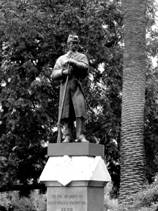
Union Soldier Statue
It took several months for the foundry
to complete the task but when the statue was finished
and erected it on the pedestal the event spawned
a joyous celebration. Hutchinson
was failing at that time and was brought in by automobile
to see the accomplishment neither he nor any member
of the board originally would have believed possible.
A book was written on many of the people
buried in Union Cemetery. The cemetery board sold
1200 copies of the book and it was republished with
some additional people included, and new information by Star
Publishing. It continues to raise money
to improve and maintain the cemetery today.
The cemetery
has been greatly improved by Boy Scouts working
on their Eagle Scout Award. The first Scout worked
on the Cooley-Frisbie plot fence that had been knocked
to the ground and had to be completely rebuilt. He
did a beautiful job. The two lawns, the paths
and a number of fences have been finished and a
bench was done by one Scout. One group built the
monument in the front of the cemetery that holds
the California State Landmark Plaque. The board
continues to welcome any groups, especially children,
who wish to improve the cemetery by doing projects,
as long as they fulfill the necessary requirements
with the city’s Park and Recreation Department and
the Historic Union Cemetery Association.
The
humble order of E. Clampsus Vitus joined the Cemetery
Association and they continue to help us every
Memorial Day as we honor those who have given their
lives for our freedom and those veterans who have
put their lives in harm’s way and survived.
An Invitation for You!
If you have not attended the Memorial Day celebration
in Union Cemetery before, please plan to do so in
the future. The community still celebrates with
a parade, speeches and flags, just as they did in
1869 to honor our veterans.
John Edmonds
President
Historic Union Cemetery Association